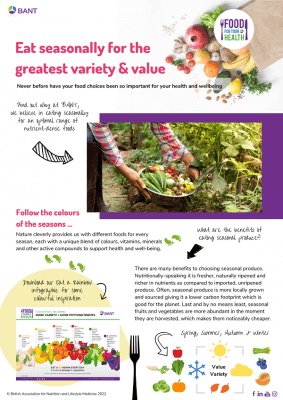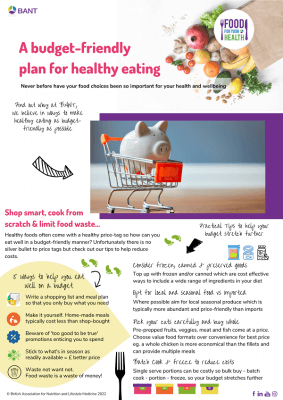
26 Sep 2022 Biodiversity – why variety matters
Eating a broad and colourful array of plant foods isn’t just beneficial for our health, it’s delicious and exciting too!
Scientists, clinical researchers and healthcare experts have long advocated the benefits of dietary diversity for our growth, development, immunity and overall wellbeing. Eating an assortment of plant foods is essential to achieving this dietary diversity and improving the ecosystem of our gut microbiome.
Studies have shown the positive effects of a high intake of plant foods such as cruciferous vegetables, berries and dark leafy greens on chronic diseases, digestive health, stress, sleep and obesity. The antioxidant, anti-inflammatory, antimicrobial and anti-cancer properties of these nutrient-rich plant-derived foods have been well documented.[1][2][3][4]
Conversely, population groups that consume fewer plant foods and rely on refined carbohydrates, saturated fats and processed foods laden with salt and sugar, have consistently been linked with poorer health outcomes.[5]
Informed by nutritional experts, public health policies and the ancient wisdom of our pre-processed food generations, we know that whole plant foods are good for us. But why is variety so important? Isn’t it enough if our weekly shop consistently includes raspberries, broccoli, carrots, peas and peppers?
If you already have colour in your shopping cart, you’re off to a great start. But the concept of variation is important principally because of the abundance of different phytonutrients that are contained in different plant food groups.
The more we can vary our diet, specifically our plant-based intake, the more enriching our microbiome will be in maintaining our wellbeing, adapting to health challenges and fighting pathogens.[6][7]
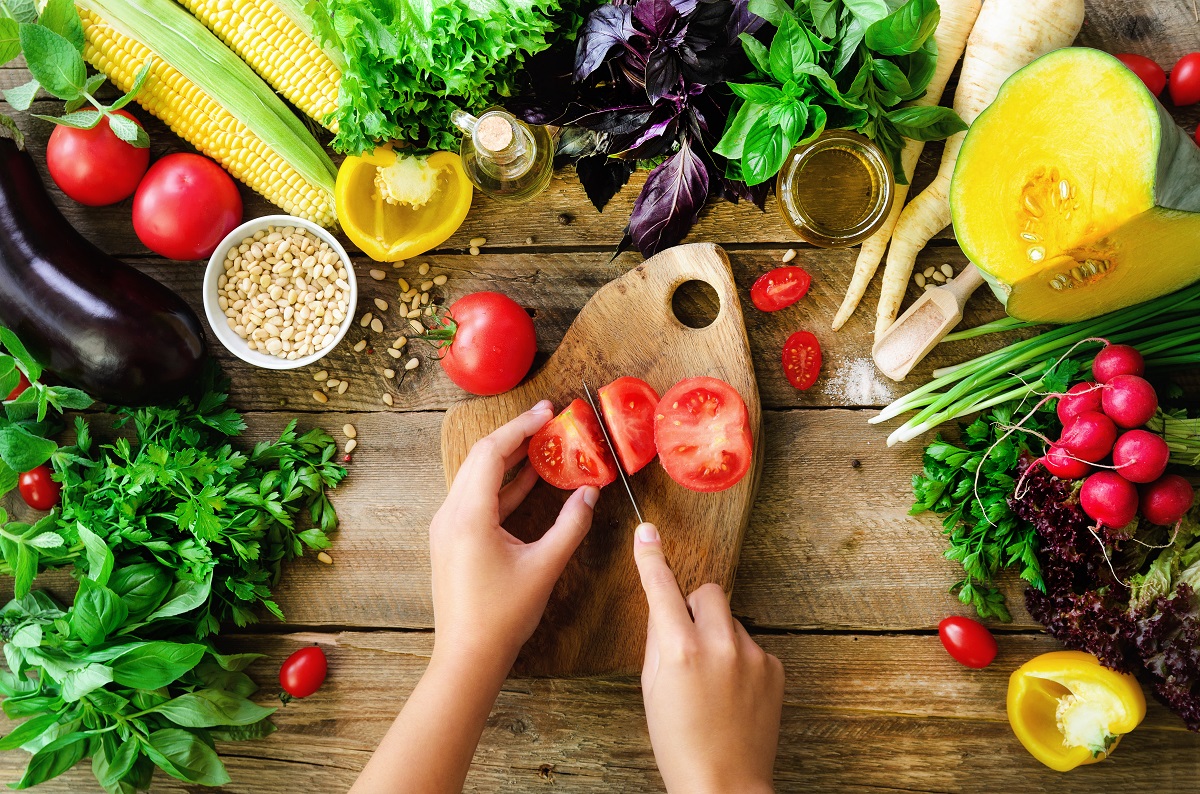
What are phytonutrients?
Simply put, phytonutrients are plant nutrients with specific biological activities that can support our health. Plants produce these chemicals as an adaptive response to maintain an evolutionary advantage in reaction to their environments. These chemicals can offer protection from insects, pests and predators; act as a medicine for the plant itself; and help with communication between plants, animals and bacteria.
Phytonutrients are found in fruits, vegetables, herbs, spices, nuts, beans, wholegrains, tea and coffee. The vivid orange pigment of papayas, the sharp irresistible scent of crushed garlic and the bitterness of your morning coffee are all the result of phytonutrients.
There are numerous categories of phytonutrients normally classified according to their chemical properties and shape. Some examples of bioactive phytonutrients include polyphenols (berries, nuts and vegetables), terpenoids (tea, thyme and citrus fruits), resveratrol (grapes, wine and blueberries), flavonoids (red cabbage, onions and parsley), isoflavonoids (soy, lentils and peas), carotenoids (carrots, sweet potatoes and pumpkins), limonoids (oranges, lemons and grapefruits), glucosinolates (broccoli, cauliflower and radishes), phytoestrogens (flaxseed, edamame and sesame seeds), phytosterols (olive oil, nuts and legumes), anthocyanins (blueberries, blackberries and raspberries), omega-3 fatty acids (chia seeds, walnuts and seaweed), and probiotics (sauerkraut, miso and kimchi).[8][9]
Researchers have studied the effects of phytonutrient consumption in depth and illustrated their individual benefits on a number of health conditions. Examining them all would be impossible, but we can look at three examples here.
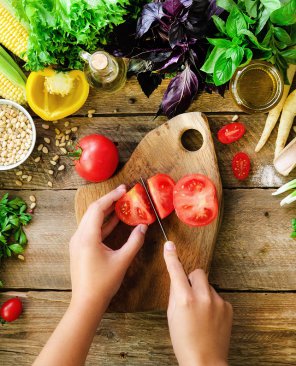 Tomatoes and tomato-based foods are rich in lycopene, which belongs to the carotenoid family of phytonutrients. While tomatoes are a key dietary source of lycopene, you can find high levels in other foods such as watermelons, guavas, grapefruits and apricots. An analysis of multiple studies involving almost 700,000 participants, showed that consuming higher levels of raw and cooked tomato and tomato sauces reduced the risk of prostate cancer.[10]
Tomatoes and tomato-based foods are rich in lycopene, which belongs to the carotenoid family of phytonutrients. While tomatoes are a key dietary source of lycopene, you can find high levels in other foods such as watermelons, guavas, grapefruits and apricots. An analysis of multiple studies involving almost 700,000 participants, showed that consuming higher levels of raw and cooked tomato and tomato sauces reduced the risk of prostate cancer.[10]
 Cruciferous vegetables such as broccoli, cauliflower and pak choi are classed as isothiocynates, which result from the breakdown of sulphur-rich glucosinolates. High consumption of these foods have shown potential to inhibit the development of cancers, reduce tumours, and detoxify and remove carcinogens from the body.[11][12]
Cruciferous vegetables such as broccoli, cauliflower and pak choi are classed as isothiocynates, which result from the breakdown of sulphur-rich glucosinolates. High consumption of these foods have shown potential to inhibit the development of cancers, reduce tumours, and detoxify and remove carcinogens from the body.[11][12]
 The effects of a diet high in quercetin, which falls under the flavanoid phytochemical group, are highlighted in studies which explore its benefits on cardiovascular health. Quercetin-rich foods including apples, onions and berries have been shown to reduce inflammation, hypertension, plaque build-up in the arteries and risks of heart attacks.[13][14]
The effects of a diet high in quercetin, which falls under the flavanoid phytochemical group, are highlighted in studies which explore its benefits on cardiovascular health. Quercetin-rich foods including apples, onions and berries have been shown to reduce inflammation, hypertension, plaque build-up in the arteries and risks of heart attacks.[13][14]
Aside from these specific conditions, phytonutrients and phytochemicals designed for plant growth and protection can be hugely beneficial to our overall health. This is particularly true when we source and eat local foods.
First off, your fruits and vegetables will often taste fresher and have a higher nutrient content as they are likely to appear in your local shop soon after harvesting. Foods picked halfway across the world will routinely wait in a warehouse before being packed up and flown over, and thus their nutrient content diminishes by the time they reach your plate.
Another advantage is that the phytonutrients of a local food have evolved to cope with your environment and so eating those foods provides a unique layer of protection that plants grown elsewhere cannot provide. In addition, sourcing foods grown in your area is a wonderful way to support farmers, agricultural spaces, shops and other communities based locally.
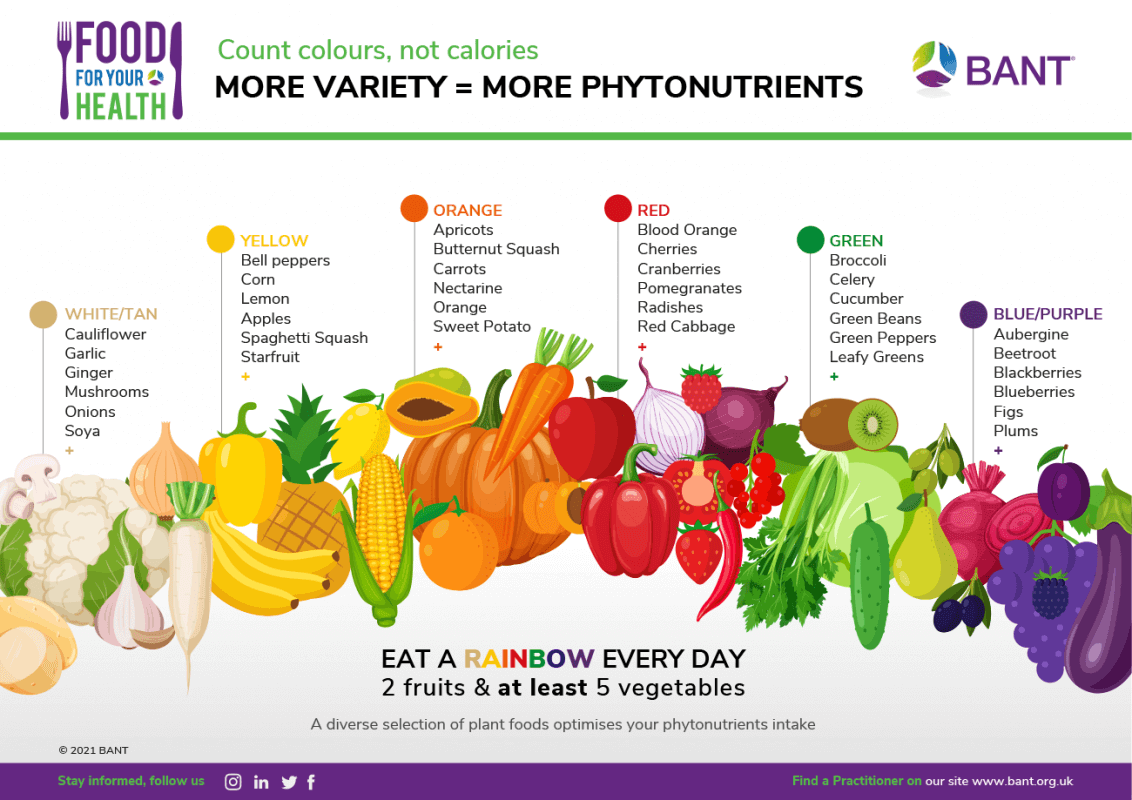
Fabulous fibre
Fibre is another compelling reason to fill your fridge with fruit and vegetables. Fibre is a type of carbohydrate that the small intestine cannot digest and is found mainly in plant foods. Fibre makes its way into our large intestine where it performs a number of activities. It ferments to produce short chain fatty acids; acts as a prebiotic to feed good gut bacteria; speeds up the passage of waste through your digestive tract, helping to eliminate toxins from your body; and helps prevent and relieve constipation.[15]
There are two types of fibre and we need both. Soluble fibre from sources such as unpeeled fruits and vegetables, oats, peas, beans and lentils, swells in water, ferments in your large intestine and can be prebiotic and viscous. It delays the emptying of your stomach so you feel fuller for a longer period of time and softens the stool.
Insoluble fibre from grains such as brown rice, wholemeal bread, buckwheat flour, potatoes with skins, nuts and seeds, does not dissolve in water, and so adds bulk to the stool, helping it move along the digestive system more quickly, thereby promoting regularity and easing elimination.
High consumption of dietary fibre has been shown to lower the risk for developing coronary heart disease, stroke, hypertension, diabetes, obesity and certain gastrointestinal diseases. It may also help to lower cholesterol and blood pressure, improve blood glucose control for diabetic individuals (as it slows the digestion and absorption of carbohydrates), and aid in weight loss.

Should I buy organic?
In an ideal world, we would all be eating beautifully organic, misshapen fruits, vegetables and herbs void of pesticides and other nasty chemicals. Unfortunately, modern agricultural processes rely on pesticides to protect plants from insects, weeds and other pests.
Pesticide residues in crops may impact our gut microbiome and put pressure on our liver, a prime organ responsible for detoxification.[16] Our liver is constantly working to process internal and environmental toxins, working to flush out hormones, antibiotics, fertilisers, food colourings, preservatives and more from our bodies.
Organic produce often contains higher phytochemical levels because plants have to work harder, without the armour of pesticides, to protect themselves from environmental threats. Long-term studies have also shown an association between increased organic intake and a reduced incidence of infertility, birth defects, allergic sensitization, metabolic syndrome and high BMI among other conditions.[17] With this in mind, organic foods offer clear benefits for our health.
However, we are also living in times of instability, characterized by messy politics, inflation and an energy crisis which has deeply impacted financial sustainability. Affordability is a real issue when it comes to our weekly shop.
But all is not lost. And you don’t need to switch entirely to organic purchases. There are ways to pick and choose organic foods that won’t break the bank.
- Look for own-brand organic ranges at your local supermarket. These giants have recognized the growing demand for organic produce and are working to make options more affordable. You might be surprised to find that staple foods such as organic carrots and potatoes are not much more expensive than their non-organic counterparts.
- Get more bang for your buck in the freezer aisle with frozen fruits and vegetables.
- Grow your own organic herbs. Even if you don’t live in a house, you can start small with pots of herbs that have a longer life than chopped and packaged alternatives.
- Consider buying organic produce seasonally, when certain foods are in abundant supply and costs are reduced.
- Think about bulk buying where discounts may be available on cupboard essentials such as rice and lentils.
- Explore your local markets and specialty supermarkets (Romanian, Polish, Turkish, Iranian, Italian) for deals on organic produce.
How to incorporate more phytonutrients in your diet
- Move away from ultra- processed foods towards a whole foods culture and get inspiration for quick and healthy recipes on BANT’s ‘Food for your health’ campaign page.
- Fill your fridge with healthy snacks such as celery, cucumber and carrot sticks, and incorporate veggies, herbs and spices into dressings and dips.
- Look out for seasonal produce to bring colour and variety to your table while saving costs. Think asparagus in the spring, peaches in the summer and pumpkins in autumn.
- Meal plan so you buy an abundance of plant foods and use them without wastage. A tray of roasted vegetables pairs well with a piece of fish or lean meat; soups can incorporate many different vegetables, herbs and spices; and steamed choi sum, or a stir fry of beansprouts, peppers, and cabbage pairs well with Asian food.
- Eat the rainbow and stick a chart on your fridge so you know you’re ticking off all those colours. It’s a great way to get kids involved too!
Author: Vandana Chatlani, Registered Nutritional Therapy Practitioner, NT Dip, mBANT, CNHC,
References:
[1] Clinical Evidence of the Benefits of Phytonutrients in Human Healthcare https://www.ncbi.nlm.nih.gov/pmc/articles/PMC9102588/
[2] Should We ‘Eat a Rainbow’? An Umbrella Review of the Health Effects of Colorful Bioactive Pigments in Fruits and Vegetables https://www.ncbi.nlm.nih.gov/pmc/articles/PMC9268388/
[3] Fruit and Vegetable Intake: Benefits and Progress of Nutrition Education Interventions- Narrative Review Article https://www.ncbi.nlm.nih.gov/pmc/articles/PMC4644575/
[4] Critical review: vegetables and fruit in the prevention of chronic diseases https://www.ncbi.nlm.nih.gov/pmc/articles/PMC3419346/
[5] Ultra-Processed Foods and Health Outcomes: A Narrative Review https://www.ncbi.nlm.nih.gov/pmc/articles/PMC7399967/
[6] A healthy gastrointestinal microbiome is
dependent on dietary diversity https://www.ncbi.nlm.nih.gov/pmc/articles/PMC4837298/pdf/main.pdf
[7] The Effects of Vegetarian and Vegan Diets on Gut Microbiota https://www.ncbi.nlm.nih.gov/pmc/articles/PMC6478664/
[8] Flavonoids: an overview https://www.ncbi.nlm.nih.gov/pmc/articles/PMC5465813/
[9] Clinical Evidence of the Benefits of Phytonutrients in Human Healthcare https://www.ncbi.nlm.nih.gov/pmc/articles/PMC9102588/
[10] Increased dietary and circulating lycopene are associated with reduced prostate cancer risk: a systematic review and meta-analysis https://pubmed.ncbi.nlm.nih.gov/28440323/
[11] The Role of Isothiocyanates as Cancer Chemo-Preventive, Chemo-Therapeutic and Anti-Melanoma Agents https://www.ncbi.nlm.nih.gov/pmc/articles/PMC6523696/
[12] Are isothiocyanates potential anti-cancer drugs? https://www.ncbi.nlm.nih.gov/pmc/articles/PMC4002831/
[13] The Effects of Flavonoids in Cardiovascular Diseases https://www.ncbi.nlm.nih.gov/pmc/articles/PMC7571023/
[14] Therapeutic potential of quercetin as a cardiovascular agent https://pubmed.ncbi.nlm.nih.gov/29966915/
[15] Effects of Dietary Fiber and Its Components on Metabolic Health https://www.mdpi.com/2072-6643/2/12/1266/htm
[16] A healthy gastrointestinal microbiome is dependent on dietary diversity https://www.ncbi.nlm.nih.gov/pmc/articles/PMC4837298/pdf/main.pdf
[17] A Systematic Review of Organic Versus Conventional Food Consumption: Is There a Measurable Benefit on Human Health? https://www.ncbi.nlm.nih.gov/pmc/articles/PMC7019963/
NOTES TO EDITORS:
The British Association for Nutrition and Lifestyle Medicine (BANT) acts as a professional body for Registered Nutritional Therapy Practitioners in one-to-one clinical practice and as a self-regulator for BANT Registered Nutritionists®. BANT oversees the activities, training, and Continuing Professional Development (CPD) of its practitioners and has a governing council, who may be non-members but whose professional experience lies in the medical, scientific or educational area of nutritional science.
Registered Nutritional Therapists are regulated by the Complementary and Natural Healthcare Council (CNHC) that holds an Accredited Voluntary Register (AVR) for the Professional Standards Authority for Health and Social Care (PSA). A report by the Royal Society for Public Health and the Professional Standards Agency made a key recommendation that AVR practitioners have the authority to make direct NHS referrals, in appropriate cases, to ease the administrative burden on GP surgeries. BANT nutrition practitioners are the key workforce asset to harness 21st century lifestyle medicine to tackle the rising tide of stress-related fatigue, obesity, Type 2 Diabetes, dementia and other chronic diseases.
To find a BANT Nutrition Practitioner, please click here
BANT WELLBEING GUIDELINES:
The BANT Wellbeing Guidelines are specifically designed to provide clear, easy to understand general information for healthy diet and lifestyle when personalised advice is not available.
BANT launched its “Food for your Health” Campaign in February 2021 to provide open-access resources to help guide the public towards healthier food choices in prevention for diet-induced disease. Download a wide range of food and lifestyle guides, recipes, infographics, planning tools and fact sheets and start making healthy choices today.


